
Surfing isn’t the easiest sport to pick up. These boards will help ease the process. Photo: Quincy Sileo//The Inertia
So, you’ve got a budding interest in surfing? Welcome. You’ll likely want a beginner surfboard to go with that newfound love of the brine. But what’s the best beginner surfboard? In brief, the best beginner surfboard is the board that you can easily stand up on and that will continue to up your wave count. Reps, after all, are the only way to improve.
Those types of boards are long (7-9 feet), wide (22 inches-plus), and have plenty of volume (probably at least 60 liters, depending on your weight). It’s also not a bad idea for them to be fairly soft, so you won’t hurt yourself or anyone else in the lineup as you get your feet in the proverbial wax for the first time.
And the wrong surfboard – one that may be better suited for an intermediate or advanced surfer – will do you no favors as they’re generally slower to paddle, much less stable when standing up, and more delicate. To make things a bit easier, we took it upon ourselves to test a wide variety of boards aimed at beginners in an effort to demystify things and aid you in the beginner surfboard buying process. The list below is broken into our recommendations for three categories: foam surfboards, soft-top epoxy boards, and hard-top fiberglass/epoxy boards. In general, we’d recommend the first category for complete beginners, and the second and third categories for more fast-tracked beginners or those who have already spent some time getting their feet wet.
Navigate to: Buyer’s Guide | Comparison Table | How We Tested
Related: The Best Wetsuits for Surfing | Best Surf Booties | More Surf Reviews
Editor’s Note: We most recently updated this article in May of 2025, checking links, adding additional information after continued testing, as well as some more photos.
The Best Beginner Surfboards of 2025
Best Beginner Foam Surfboards
Wavestorm Classic
Catch Surf Odysea Log
Wave Bandit EZ Rider
Formula Fun DOHO
Best Beginner Soft-Top Epoxy Surfboards
ISLE Coronado
Boardworks Froth
JJF By Pyzel Log
Best Beginner Hard-Top/Fiberglass Surfboards
Degree33 The Ultimate Longboard
Torq Longboard
The Used Surfboard
Best Beginner Foam Surfboards
Foam surfboards are soft all the way through, meaning there’s less of a chance to hurt yourself and others in the lineup. They’re also harder to ding, and in general, are more beginner-friendly than a hard surfboard. They lack performance, but you won’t really need that extra performance as you begin your surfing journey.
Wavestorm Classic ($260)
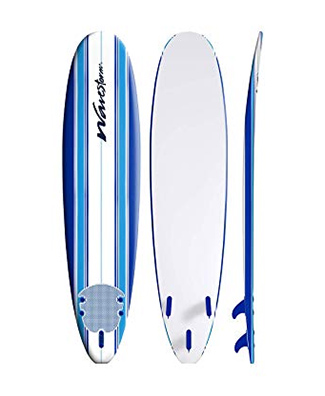
Length: 7′, 8’
Dimensions (8′): 8′ x 22.4” x 3.25”
Volume: 86L
Fins: Thruster
Construction: Foam body, three wood stringers, slick HDPE bottom, foam deck, screw-through fins
Pros: Affordable, user-friendly, very buoyant
Cons: Hard to turn
If one single board has become iconic for beginners, largely due to its low cost, ease of use, and availability, it is the Wavestorm. Jamie O’Brien famously broke the internet (and his board) taking a Wavestorm out at Pipeline attempting mid-wave board transfers – later, taking full advantage of Costco’s generous return policy.
But, how do the things surf? Well, there’s a reason that Wavestorms never caught on at Pipeline. The screw-through fins typical of many foam boards don’t offer much stiffness, and the rails are not foiled (in other words, they have a hard edge from nose to tail). These sorts of performance considerations, though, matter less when the object of the game is to get a bunch of waves and go mostly straight or down the line.
The board is easy to paddle and actually catches waves very well. It has a slight nose rocker to keep from pearling, is made with an EPS core and three marine-ply stringers for surprising stiffness, and comes with three plastic fins. There’s even a tail pad for increased traction. Furthermore, once you’ve passed the stand-up-and-go-down-the-line stage of learning to surf, there are ways to upgrade your Wavestorm, such as the Perfect Storm Single and Twin+1 Fin Systems for increased maneuverability, momentum/drive, and to prevent sliding out on steeper waves.
Fin conversion aside, you can’t go wrong with a Wavestorm. Can you do better? Definitely. But nobody would knock you for getting a Wavestorm as your first board and, in fact, many recommend it. Like, right now. We recommend it. Read our full review of the Wavestorm Classic here.
Editor’s Note: After many, many years of being available for $99 from Costco (membership required), the Wavestorm has been replaced by this Gerry Lopez soft-top surfboard made by California Board Company. Reviews, though, are mixed as the Gerry Lopez is a bit flimsier and has less volume, resulting in less buoyancy and stability. At $150, if you already have a Costco membership, this is probably the cheapest price you’ll get for a new surfboard, but sans membership, you’ll likely be happier paying a bit more for a classic Wavestorm. For an upgrade, see our other foam board options below, like those from Catch Surf and Formula Fun.
CHECK PRICE ON AMAZONCatch Surf Odysea Log ($399)
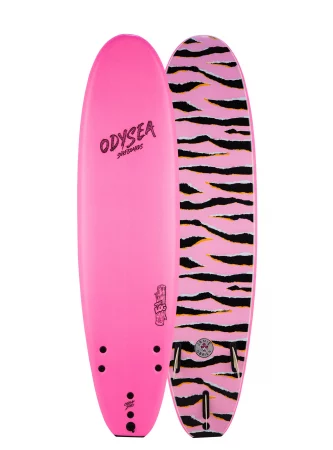
Length: 7′, 8’, 9′
Dimensions (8′): 8′ x 23” x 3.375”
Volume: 86L
Fins: Single (Catch Surf Plank) or Thruster
Construction: Foam body with three wooden stringers, slick plastic bottom, and soft PE deck, fin boxes
Pros: Legitimately soft and user-friendly foam board that performs a bit better than your average Wavestorm
Cons: Brand name carries a higher price tag
Catch Surf foam boards are constructed very similarly to a Wavestorm. They’re foam through and through, save for the wooden stringers, with a squishy foam deck that wraps over the rails and a slick plastic layer on the bottom. And while J.O.B. on a Wavestorm may have started the “foam boards are cool” revolution, Catch Surf has carried the torch so much further than we could have possibly imagined. The company did this by paying pro surfer jokesters like Jamie O’Brien and Kalani Robb to surf these previously “silly” beginner boards. They quickly proved two things: that pros can rip on anything, and that foam boards are entirely rippable. And Catch Surf’s foam boards are particularly rippable for a full-foam construction surfboard.
While still foam, like the rails of a Wavestorm, Catch Surf rails are slightly foiled, making them a bit easier to turn. The boards are also constructed with fin boxes instead of screw-through fins. That adds extra stiffness, letting you hold a line on a steeper wave face without sliding out, but the full-foam body means there will still be some give. If that’s a concern for you, consider a board like the Formula Fun surfboards, below, or any of the soft-top epoxy boards listed further down this list, which will both be definite upgrades in performance over a full-foam board like a Catch Surf, Wave Bandit (below), or Wavestorm.
Catch Surf’s longer boards come in two styles, the Log and the Plank. The Log comes with a three-fin thruster setup, providing extra stability for newer riders, while the Plank’s single fin provides better performance for more experienced riders.
CHECK PRICE ON Evo CHECK PRICE ON REAL WATERSPORTSWave Bandit EZ Rider ($350)
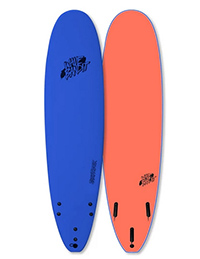
Length: 7′, 8′
Dimensions (8′): 8′ x 23″ x 3.375″
Volume: 86L
Fins: Thruster
Construction: Foam body with two wooden stringers, slick plastic bottom, and soft EVA deck, screw-through fins
Pros: All-around great beginner surfboard, full-foam construction
Cons: Not quite the same level of construction as Catch Surf boards
Wave Bandit is Catch Surf, Catch Surf is… Wave Bandit? Basically. While Catch Surf might be the brand name most will recognize, Wave Bandit is their slightly more wallet-friendly little sister. Instead of three wooden stringers, Wave Bandit boards have two. Instead of fin boxes, Wave Bandit boards have screw-through fins. And that’s about it as far as differences go. Even the board dimensions are fairly identical. And Wave Bandit has even achieved its own cult following thanks to the well-known and well-loved surf vlogger Ben Gravy (who’s a sponsee).
So, as a beginner surfer, which one should you choose? Well, like most things in life, that depends. Performance-wise, as a beginning surfer, you won’t be able to tell the difference between three wooden stringers or two, and fin boxes or screw-through fins on a foamie. There’s a chance the three stringers on a Catch Surf will be less likely to break than the two stringers of a Wave Bandit, but it’s not like these boards are prone to breaking to begin with. If you want to save $50, go with the Wave Bandit. If you want to ride a slightly better-constructed, and certainly more recognizable brand-name board, go with a Catch Surf.
CHECK PRICE ON REAL Watersports CHECK PRICE ON Amazon
Formula Fun DOHO ($599)
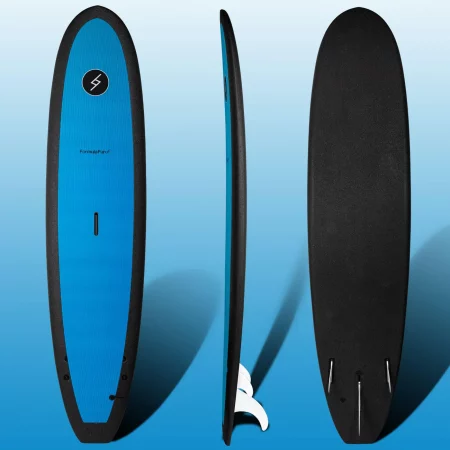
Length: 8′
Dimensions (8′): 8′ x 22.5″ x 3.36″
Volume: 78L
Fins: 2+1 (single fin with two side-bites for stability)
Construction: Co-polymer recyclable foam body with a single wood stringer, Futures fin boxes
Pros: Fully recyclable, 10” single fin finbox, stiffer, more durable foam body
Cons: A pricier choice
Marko Foam has been an industry leader in the manufacturing of foam surfboard blanks for decades and has long championed the transition to materials that are friendlier to the planet. Some years back, the guys at Marko cooked up a way to manufacture foam surfboards that are fully recyclable instead of going straight to a landfill if and when they break. They call the line Formula Fun, and they’re just that. A freakin’ blast. They achieve this by making the boards entirely out of a stiffer closed-cell foam. We’ve tested a couple of different boards in this construction and have been big fans of the balance between performance (shaped rails, fin boxes, and a stiff construction) and ease of use (it’s still a foam board).
For beginners, we recommend the DOHO of all the boards in the Formula Fun line. At eight feet and with 78 liters of volume, it’s the ideal size for maximum paddle-ability and stability. The DOHO comes in a 2+1 fin setup, meaning a longboard-style finbox in the middle with smaller fins on the sides. The middle fin box is a traditional screw-in, 10-inch fin box, so you can upgrade your fin setup to your favorite longboard fin, and the side fins are Futures fin boxes, so those can be upgraded, too. At $599, the DOHO is one of the more affordable boards in the line, while still boasting some more premium features.
Other great beginner surfboards made by Formula Fun include the 9’6″ SanO, which is a great choice for larger beginners. Formula Fun has also partnered with some top-tier shapers to bring its construction to a wider audience. Almond Surfboard’s 8′ Joy model boasts a pintail and single fin, similar to the Rincon, with a bit more volume packed in. Album’s Formula Fun board is called the Kookalog (very similar to the DOHO) and has a 2+1 fin setup, while the near-identical Positive Vibe Warriors Scout sports a single fin. For a beginner surfboard, you can’t go wrong with any of the above, and many would argue, you can’t go any better, either.
check price on formula funOther Foam Surfboards
There are a number of other incredible foam surfboards on the market that make good beginner surfboards. Softech is a brand that makes a number of good shapes, as well as Surftech, and MF Softboards. Another recent addition to the market is the Phantom line of recyclable foam boards from SIC Maui. Similar in construction to the Formula Fun surfboards, these boards use FCS fins instead of Futures fins, and have a very beginner-friendly shape.
Best Soft-Top Epoxy Surfboards
Soft-top epoxy surfboards pair a durable epoxy-construction core with a thin layer of foam on the deck and rails. While the board is still quite hard underneath, the foam helps prevent dings as well as injury to yourself and others. This is a great middle ground between a true foam board and a “real” hard-top surfboard, providing some measure of the benefits of a foam board without compromising too much on the performance of a hard-top surfboard.
ISLE Coronado ($595)
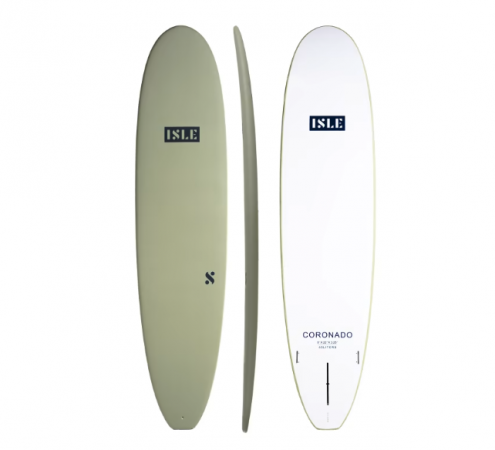 Length: 8′
Length: 8′
Dimensions (8′): 8′ x 22″ x 3.25″
Volume: 65L
Fins: 2+1, center single fin box with FCS side-bite fins
Construction: Epoxy core with soft foam deck padding
Pros: Great construction, great beginner shape, great price
Cons: Rails lose some performance over a hard board due to being covered in foam, and not many sizes to choose from
The Coronado from ISLE is a definite step up in the soft board category. With a strong epoxy-construction core, no-wax-necessary soft top, and 2+1 fin system, this is a board anyone can rip on. This is a true soft-top epoxy surfboard.
What does that mean? Well, it’s basically a hard surfboard that’s pretending to be a foamie. In a classic soft-top epoxy construction, the core of the board (made of a fully glassed EPS foam core, basically a surfboard by itself) is wrapped on the deck and rails with a thin layer of foam to provide some padding and grip on the deck while maintaining a similar level of performance to a true hard-top surfboard.
That’s the case with the Coronado. The rails lose a bit of performance in comparison to a hard board, but it’s a massive step up over the performance of a true foamie surfboard. The fin boxes are a big point of differentiation here, as the epoxy core of the board provides a rigid base to secure the fins into. While the board isn’t available in a lot of different size options, it’s very competitively priced, and one of our top picks for beginner surfboards. If you’re worried that a Wavestorm or other foam board will hinder your progression, look no further than a soft-top epoxy board like the Coronado. For even more performance, see the JJF by Pyzel Log, below. Read our full review of the ISLE Coronado here.
CHECK PRICE ON ISLEBoardworks Froth ($490)
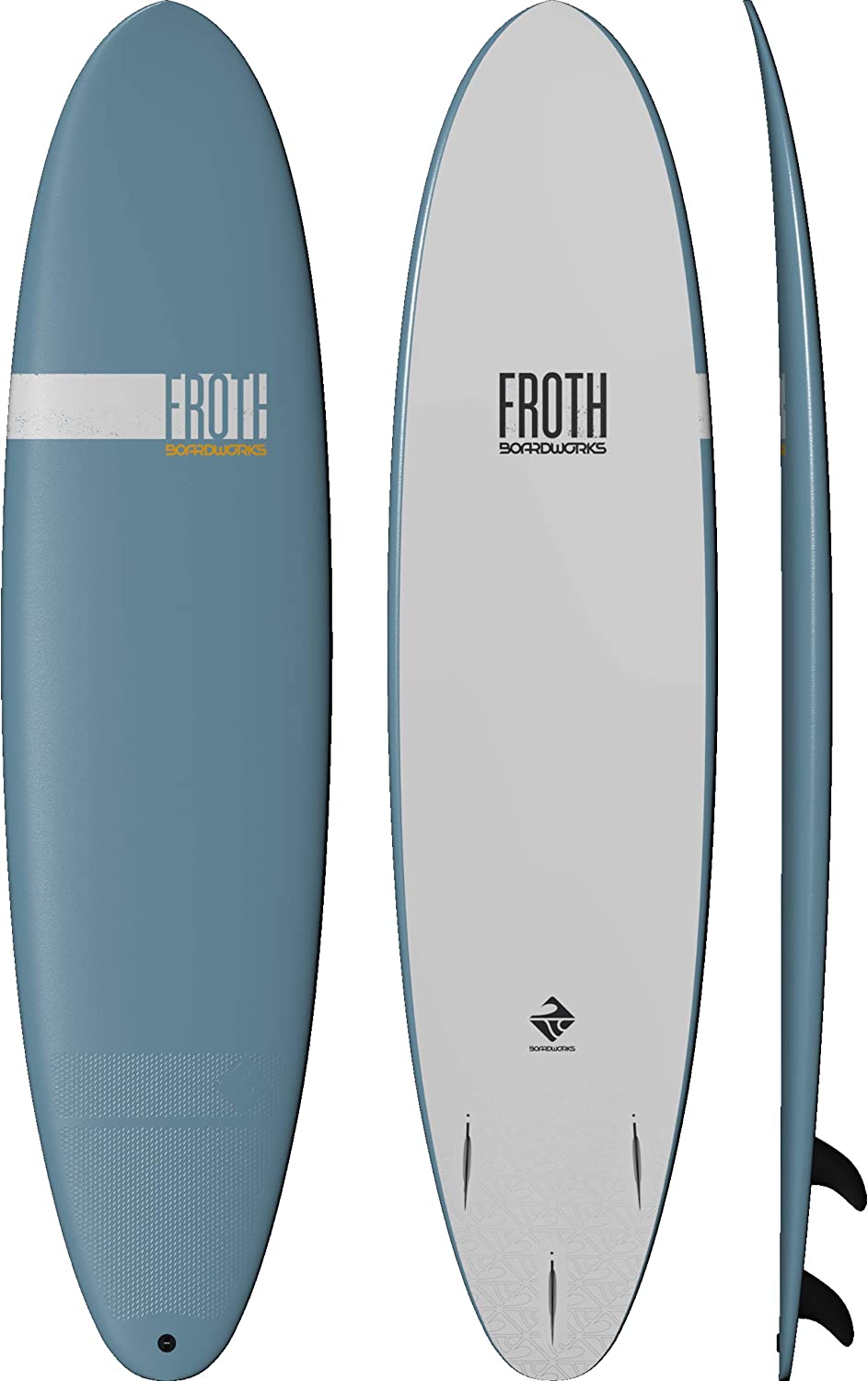
Lengths: 7′, 8′, 9′
Dimensions (8′): 8′ x 23″ x 3.38″
Volume: 71 L (8′)
Fins: Thruster or single fin
Construction: Epoxy core with soft foam deck padding
Pros: Futures fin boxes, user-friendly shape
Cons: Some complaints about construction/long-term durability
The Boardworks Froth line of surfboards is one of the most affordable soft-top epoxy boards on the market. With a durable EPS core, foam deck layer that wraps the rails, and Futures fin boxes, the board delivers everything you would expect from a soft-top epoxy. The board’s profile and design are another plus – decidedly beginner-friendly, with an all-around shape that won’t hold you back in bigger (or smaller) surf.
It’s available in 5′, 5’6″, 7′, 8′, and 9′, so take your pick, but beginners should definitely go with the 7′, 8′, or 9′, depending on weight and the wave you’ll be learning at. All boards come with fins; the 9′ version has a single-fin box and fin, and the smaller boards come with Futures fin boxes in a three-fin thruster setup.
Though we have yet to experience any issues, a small number of Amazon reviews of the product from 2020 speak to board delaminations and issues securing the fins. While we have yet to experience any such issues ourselves, it’s always worth keeping in mind when making an online purchase. In any case, the lack of recent negative reviews leads us to believe Confluence Outdoors (the Boardworks parent company) has stepped up its quality control in recent years.
CHECK PRICE ON AMAZONJJF By Pyzel Log ($650)
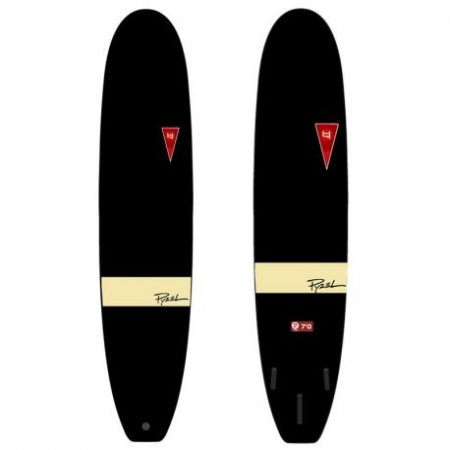
Length(s): 7′, 8′, 9′
Dimensions (8′): 8′ x 23.25″ x 3.6″
Volume: 81L
Fins: 2+1 or thruster
Construction: Soft foam deck, epoxy core, Futures fin boxes
Pros: Solid construction, easy to get up on, great performance with shaped rails
Cons: Expensive
As far as performance goes, any hard-top surfboard is going to do better than a foam surfboard. Soft-top epoxy boards blur that line with a durable (and stiff) epoxy core and a thin layer of foam on top. The rails, however, being wrapped in foam, lose some of their shape, and consequently, a bit of performance, too.
The JJF by Pyzel line of soft-top epoxy surfboards seeks to regain some of that performance. The rails are still wrapped in foam, but the foam that’s used is a bit stiffer than other soft-top epoxy boards we’ve encountered. Most notably, the foam rails are shaped, hand-sanded, actually, similar to the rails of a classic hard-top surfboard. Even an advanced surfer will be hard-pressed to notice a difference in performance. The boards also sport Futures fin boxes. The eight- and nine-foot versions come with a 2+1 fin setup, while the seven-foot board comes with a thruster design.
That said, this board clocks in much higher on the price spectrum than your run-of-the-mill beginner board. At this price point, we’d almost recommend one of the hard-top beginner boards below. They’re also notoriously difficult to find in stock. But for those who want to blast from zero to hero on one surfboard, this is a great choice. However, beginners who are unsure if the extra $150 over boards like the ISLE Coronado, above, will make that much of a difference are likely better served to put that money towards a high-quality wetsuit or their next surfboard.
Check Price on Soft Board CenterOther Soft-Top Epoxy Surfboards
There are a number of other surfboard manufacturers who make soft-top epoxy surfboards. Degree33, whose Ultimate Longboard is featured in the hard boards section below, also makes nearly all of their surfboards in their Hybrid Epoxysoft soft-top construction. Torq makes its longboard in a foam-covered version. Here’s another awesome soft-top funboard from The Critical Slide Society, and here’s one from Modern Surfboards.
Best Hard-Top/Fiberglass Surfboards
Hard-top/fiberglass surfboards are the least user-friendly type of surfboard for beginners. Their hard fiberglass-and-resin construction can injure you in a tumble, ding, or damage, happens more easily, and requires frequent waxing. The boards we have listed here are epoxy-construction, hard-top surfboards, made of a tougher material than traditional surfboards that won’t break as easily but will hurt just as much if they hit you, and still require wax.
Degree33 The Ultimate Longboard ($800)
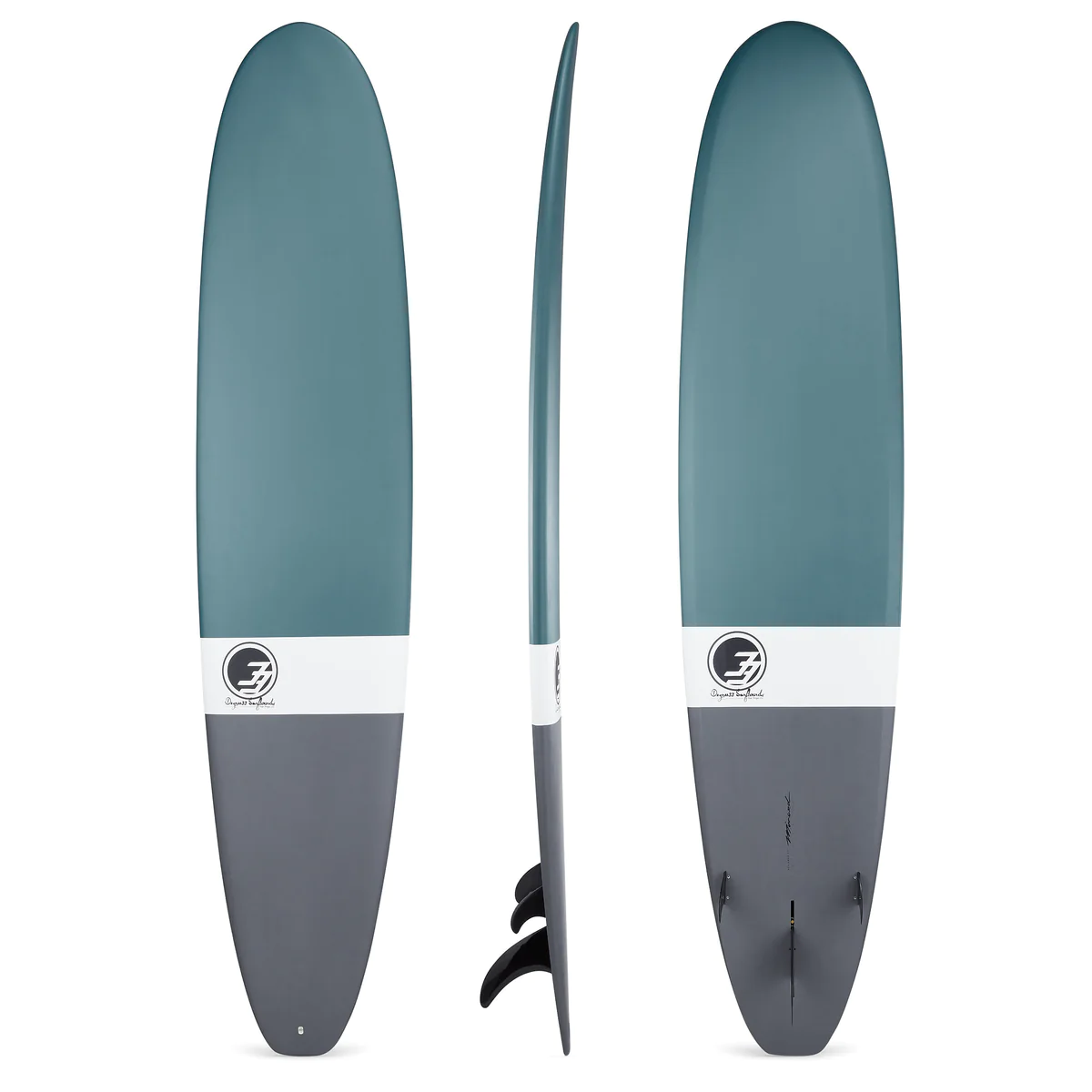
Length(s): 7′ – 10′
Dimensions (8′): 8′ x 22.5″ x 2.75″
Volume: 57.5 L
Fins: 2+1
Construction: Epoxy sandwich
Pros: Beginner-friendly design that’s still a worthy addition to the quiver at higher levels
Cons: Expensive, hardboard will hurt if it hits you or others
Degree33’s The Ultimate Longboard lives up to the name when it comes to learning to surf. This board was literally designed with beginners in mind. It’s got plenty of volume throughout the length of the board (but not so much that it hinders one’s progression), an interesting beveled rail design to promote turnability, a 2+1 fin setup, forgiving rocker profile… this board has it all, and truly excels in all conditions from knee-high dribble to head-high rollers. We’d recommend the eight- or nine-foot model for most adults, but the Ultimate comes in a wide range of sizes from seven to 10 feet.
And it’s surprisingly fun at higher levels of surfing as well. We got a chance to try out a 9’0″ and were impressed with the speed and maneuverability of the board’s shape. For those on a fast-tracked beginner progression, this board will not slow you down, and the board’s progressive longboard shape will have you well-prepared for when the time comes to move on to a smaller board.
The epoxy sandwich construction is exceedingly durable, perfect for enduring the inevitable spills and bumps that come with learning to surf. With the proper care, this board will last far longer than any foam surfboard, but it will hurt considerably more if you and the board have an awkward encounter, so be forewarned.
This board (and basically any board in the Degree33 lineup) also comes in a hybrid soft-top epoxy construction very similar to the ISLE Coronado.
For those interested in a board in the seven-foot range, instead of stepping down the Ultimate Longboard, we’d recommend taking a look at the Poacher, a more egg-shaped board, which is often a better shape for boards of that size.
CHECK PRICE ON Degree33Torq Longboard ($530)
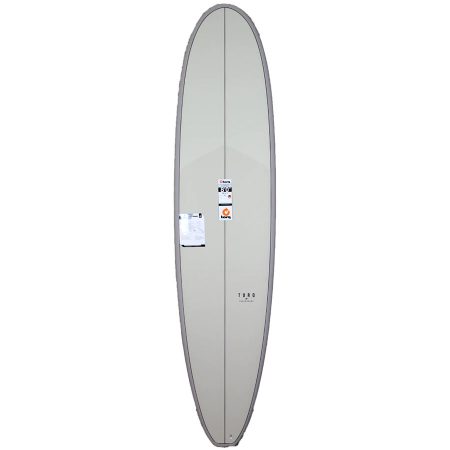
Length(s): 8’, 8’6″, 9′, 9’1″, 9’6″
Dimensions (8′): 8′ x 22” x 3″
Volume: 60L
Fins: Thruster (8′), 2+1 (all other sizes)
Construction: TET epoxy sandwich
Pros: Versatile, Futures fin system, great price
Cons: Know what you’re getting into by starting with a hard board
When looking at the category of hard-top beginner surfboards, Torq is a name that should carry a lot of weight. Their TET construction is one of the better epoxy-sandwich constructions on the market, and their boards sport user-friendly shapes. Torq’s Longboard, made in its TET construction, is a super versatile, super durable, and user-friendly board that comes in a wide variety of sizes. The board’s shape toes the line between supremely user-friendly and advanced enough that it won’t hold you back as you progress. The TET construction is insanely durable, meaning this is a board that can stay in your quiver for years to come, even after you’ve beaten it all to hell during your beginner phase.
The 8’0″ has a thruster set up for a more funboard feel, while the 9’1″ and 9’6″ sizes of the board feature a slightly wider tail and nose, making them more usable as noserider longboards, if you’re looking to progress in that direction, instead of/in addition to shortboarding. For those interested in a smaller-sized board, Torq’s Mod Fun egg-shaped funboard is what we’d recommend for beginners.
CHECK PRICE ON CleanlineOther Hard-Top Surfboards
The world of hard-top surfboards is as wide-ranging and nebulous as the sport of surfing itself. However, there are a number of board manufacturers who make so-called “epoxy-sandwich” construction surfboards that are super durable and very well-suited to beginner surfing. Surftech’s Tuflite construction is one such ultra-durable epoxy sandwich, and its lineup sports legendary shapes like Donald Takayama’s In The Pink performance longboard, among others.
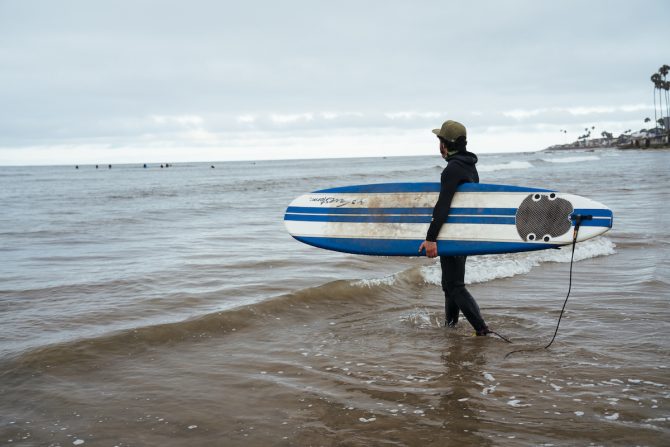
The Wavestorm. Probably THE place to start when the surf bug bites. Photo: Daniel Zweier//The Inertia
The Used Surfboard
The last item on this list is nebulous. A used surfboard is a magic quest in which you will always find something, but rarely exactly what you were looking for.
For a beginner, used is an excellent way to go. It should be cheaper, induce less stress, and make the whole process of starting this epic sport way more casual. These are good things.
The key is to know how to look. A used Wavestorm is fantastic. Actually, a used version of any of the boards on this list will be worth it, granted they don’t have gaping holes or are being sold for anything more than their retail price (beware the $300-dollar Wavestorm).
There are a few key qualities when looking for a used beginner surfboard:
1. Long, wide, and (probably) foam.
2. Under $200. As the list above shows, there’s a wide variety of prices for brand-new beginner surfboards, but they’re not crazy expensive (for the most part). If you’re going the used route, at least make sure it’s financially worth it.
3. No holes, especially on the bottom of the board. Foam boards are usually made of epoxy, which is harder to damage and has more float. But it’s also a lot harder to repair, especially in foam-topped beginner surfboards. Whether you go for a hard-top board or a foamie, make sure it is free of holes and cracks. On foamies, this matters a lot less. Most all-foam constructions use closed-cell technology, meaning dings and slices just won’t take on water. But for fiberglass/epoxy surfboards, a good rule of thumb is that if you can catch your fingernail on the edge of a ding or crack, it’s probably not watertight. And if you’re going to fix a surfboard hole yourself, keep in mind that polyester resin and epoxy surfboards don’t do well together. If you’re looking for a quick fix, ding tape can do a pretty awesome job.
4. Comes with fins. Many foam beginner surfboards have custom fins that don’t match up with FCS, Futures, or even stock single-fin boxes. They are therefore much harder to find, if not included.
If you take the time to find a used board, you will save money one hundred percent of the time. But that might not be your style, and trolling C-List all day can get wearisome, as well as the difficulty of tracking some random internet dude down so you can buy the stuff he’s used so much he doesn’t want anymore.

A few of our favorite soft-tops of different sizes (we actually wouldn’t recommend the board on the right for beginners). The longer the board, the easier it’ll be to stand up (and stay up). Photo: Will Sileo//The Inertia
Best Beginner Surfboards Comparison Table
| Surfboards | Cost | Length | Width | Thickness | Volume | Type |
| Wavestorm Classic | $260 | 8′ | 22.4″ | 3.25″ | 86 L | Foam |
| Catch Surf Odysea Log | $399 | 8′ | 23″ | 3.375″ | 86 L | Foam |
| Wave Bandit EZ Rider | $350 | 8′ | 23″ | 3.375″ | 86 L | Foam |
| Formula Fun DOHO | $599 | 7’10 | 22.5 | 3.36 | 78 L | Recyclable Foam |
| ISLE Coronado | $595 | 8′ | 22″ | 3.25″ | 65 L | Soft-Top Epoxy |
| Boardworks Froth | $490 | 8′ | 23″ | 3.38″ | 71 L | Soft-Top Epoxy |
| JJF by Pyzel Log | $650 | 8′ | 23.25″ | 3.6″ | 81 L | Soft-Top Epoxy |
| Degree33 The Ultimate Longboard | $800 | 8′ | 22.5″ | 2.75″ | 57.5 L | Hard-Top/Fiberglass |
| Torq Longboard | $530 | 8′ | 22″ | 3″ | 60 L | Foam/Epoxy |
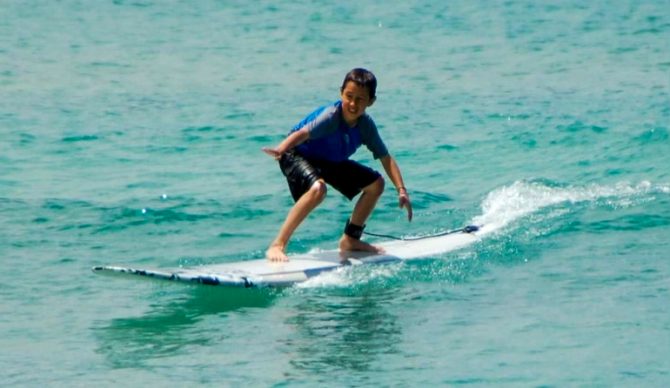
Senior Gear Editor Will Sileo began his surfing journey on a foam surfboard in Kauai. Photo: Michele Sileo//The Inertia
How We Tested The Best Beginner Surfboards
In order to test these boards, our team took them to the water to see how they performed. The lead tester for this review is The Inertia’s Senior Gear Editor, Will Sileo. Sileo resides in the Bay Area and has been able to sample all of the boards in this review over the years, spending many sessions on Wavestorms and Catch Surf boards in particular while attending college in Southern California. As well as his own experiences, Sileo has spent a number of hours teaching friends and family with many of the boards in this review to get a sense of the pros and cons of each for the beginner surfer.
Featured Gear Writer Dylan Heyden also contributed to this review, lending his experiences with the Formula Fun brand of boards, as well as his engaging writing style, to craft the intro and buyer’s guide. Although both Sileo and Heyden are experienced surfers, they remember what it was like to learn and the qualities to look for in a good beginner surfboard. Namely: long, wide, and lots of volume. We’d also like to recognize Danny Zweier, who wrote the original 10 Best Beginner Surfboards version of this article back in 2019.
Editor’s Note: This review originally ran in September of 2021. Since then, we’ve beefed it up a lot, adding some additional sections to our buyer’s guide, updating the format, and adding pros and cons for each surfboard. We’ve also added some new boards to hit the market, such as the Degree33 Ultimate and the ISLE Coronado. In August 2024, we added the Formula Fun line of surfboards. In our most recent update in May of 2025, we made sure all of our links were in working order, added some photos, and updated the entire article to make it more user-friendly and helpful to our readers.

Talking strategy before heading out on a couple of beginner, soft-top surfboards. Photo: Jenna Miller//The Inertia
Beginner Surfboard Buyer’s Guide
What Type of Beginner Surfboard Is Right For Me?
We’ll get into all of this below, but for now, here’s the TLDR: If you’re absolutely new to surfing, in all likelihood, a foam surfboard is the way to go. Probably around 8′ long for the average adult, 9′ plus for larger adults, and potentially 7′ or even smaller for teens and children who would benefit from having less board to haul around. Beginners who have gotten out a good number of times already can stand, and are turning and “going down the line” (riding the unbroken or “green” wave face), might consider taking the plunge on a soft-top epoxy or hard-top surfboard.
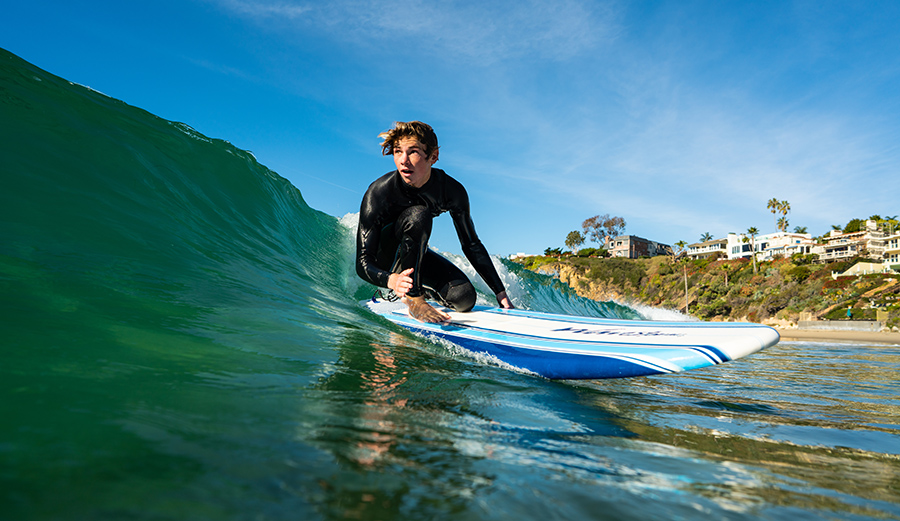
8′ Wavestorm
The right board, for the right amount of money. The classic Wavestorm is perhaps the most ridden surfboard in history and has taught thousands how to surf. We can’t recommend it enough.
Price: $200+
Different Types of Beginner Surfboards
What’s the Difference Between a Fiberglass Surfboard and a Soft-Top Surfboard?
This question has gotten more and more complicated over the years. Nowadays, soft-top/foam surfboards come in varying degrees of softness, and soft-top epoxy surfboards present a more “beginner-friendly” version of the classic PU or EPS fiberglass surfboard, blurring the lines between hard-top and soft-top surfboards.
“True foamie” surfboards like the classic Wavestorm or Catch Surf boards on this list are foam through and through. There’s a wood stringer in the middle, but that’s about it, leading to a very soft and, well, beginner-friendly construction as they’re less likely to hurt you or anyone else in the lineup. That softness comes at the cost of a decent bit of performance, but for true beginners, a foam surfboard cannot be beat. Formula Fun’s surfboards also fall under the “true foamie” label but are made with a stiffer foam that is a small step up, performance-wise, over the foam used in a Wavestorm or similar foamie.
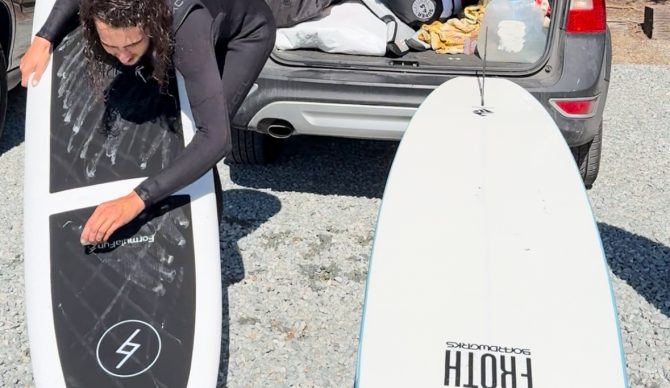
Even a foamie surfboard can benefit from a bit of wax to help your feet stick to the deck. Photo: Michele Sileo//The Inertia
Soft-top epoxy boards pair a performance-oriented and very durable sandwich-construction epoxy core with a thin layer of foam covering the deck and rails. Much harder to ding, almost as much performance as a hard board (the soft rails detract somewhat), and less potential to cause injury (though not as much as a true foamie) – these are a pretty worthy compromise for beginner-intermediate surfers.

Calling these boards from ISLE “soft-tops” does them a disservice. Sure, they have a layer of foam on top, but the epoxy body is a true performer and fun for all levels of surfers.
Hard-top sandwich construction surfboards like Surftech’s Tuflite technology thread the needle in terms of durability and traditional PU/EPS feel. They may not be as high performance, but they’re bulletproof and seemingly last forever, which makes them great beginner hard top surfboards.
At a certain point in your surfing progression, a soft board (even a soft-top epoxy board) will start to hold you back, and a more traditional fiberglass surfboard –either made with a polyurethane (PU) or expanded polystyrene (EPS) foam core glassed with fiberglass and resin– will be the solution. However, hard-topped surfboards add stress in different ways. First of all, they have to be waxed regularly for traction, which can leave a mess in your car if you don’t have a board bag.
More pointedly, fiberglass surfboards break. They seem like sturdy hunks of foam and glass, but true fiberglass surfboards are actually fragile creatures that can barely take a fall onto a carpeted surface, much less a rock to the face. You have to repair them, and then they’ll break again. Foam boards can break, too, but it matters less since dings on a foam board don’t really take on water, and they almost never have to be repaired.
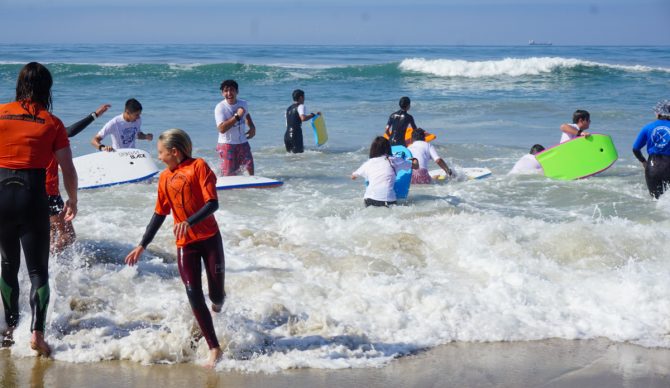
Boogie boards are another great starting point for getting comfortable in the waves. Photo: Will Sileo//The Inertia
Third, hard-topped surfboards can injure people. Technically, so can foam surfboards, but it’s not so easy to do so. Complete beginners will understandably have almost no control over the direction and speed of their surfing, which means they are prone to running into (and over) people. This hurts a lot less when the surfboard is made of foam.
Finally, hard-topped boards are expensive. Surfing, on the whole, is an expensive sport. Wetsuits, leashes, a vehicle for transport, and time to do literally nothing but be in the ocean. The list adds up to money. As a complete beginner, you may not even know if you like it. Do you buy a standard-edition Gibson Les Paul before your first guitar lesson or the cheap Epiphone?
With all the apparent hate on hard-topped boards above, let’s be clear: there is no doubt that a fiberglass surfboard will ride better than any foam surfboard. Plain and simple. The fins will engage and hold on a steeper wave than a foam board, the turns will feel better, and the rail will lock in and generate drive and speed as you fly down the line. There’s no denying this fact. If you stick with surfing long enough, you’ll want a fiberglass surfboard at some point. So if your heart is set on it, and you’ve perhaps had some time to get comfortable with the way of things on a foam board, a hard-top board might make the most sense.

Longboards and funboards make great beginner surfboards. Photo: Will Sileo//The Inertia
Different Types of Hard-Top Surfboards
Hardtop or fiberglass surfboards are where it’s at in terms of performance. There’s a reason why pros don’t ride foam surfboards – they simply don’t surf as well as hard boards. However, even within the category of hard-top surfboards themselves, there are some distinctions in terms of how the board is constructed.
“Traditional” foam-and-fiberglass surfboards are made of a foam blank – Polyurethane (PU) Expanded Polystyrene (EPS) – shaped and then glassed with layers of fiberglass cloth, stiffened by polyurethane or epoxy resin depending on the foam that the board started out with (epoxy resin can be used on any type of foam, whereas PU resin can only be used on PU foam as it melts epoxy foam). Pro tip: it pays to know what type of foam your board is made out of. These boards provide the highest level of performance, but are also the most delicate, requiring care to keep them from dinging. Here’s another pro tip: get your fiberglass surfboard a board bag.
Epoxy construction or “sandwich” boards make use of layers of EPS foam, epoxy resin, fiberglass cloth, and other materials to produce a board that is very light, very stiff, and supremely durable. Surftech’s Tuflite construction is one of the most popular examples of this construction. So much stiffness is actually not a plus for high-performance surfing – advanced riders prefer a bit of flex in their boards to absorb chop and because it “feels better,” but these are hardly concerns for the beginner surfer – sandwich construction boards make great beginner surfboards for their durability and buoyancy while providing near-identical performance characteristics. Both of the hard-top surfboards we recommend above (The Degree33 Ultimate and Torq Longboard) are sandwich-construction surfboards.

The beauty of soft tops is that even if you “ding” it, you can still ride it without much worry. Photo: Will Sileo//The Inertia
Beginner Surfboard Size and Shape
Discussing the ideal size and shape of a beginner surfboard requires a slight detour to talk about progression. Every surfer – seriously, every surfer – begins their surfing journey in the soup of white water, practicing their pop-up and going straight toward the beach. It may not look like the sort of surfing you see in clips online, but crawling doesn’t look much like walking. As you progress from surfing’s equivalent of amniotic fluid to real-deal cresting waves, the ideal surfboard is one that allows you to paddle fast and gives you a fairly stable platform to perfect your pop-up. Once there, you’ll gradually start to go down the line, riding the unbroken part of the wave. And all of this is before you even begin to think about maneuvers.
It’s also worth noting some key terms about design. A board’s dimensions are generally noted in three specs: length x width x thickness. Manufacturers will also generally let you know the volume of a surfboard – the more volume, the more buoyant. Buoyancy equates to easier paddling as more of the board sits on top of the water, as well as a more stable surface when standing up. Greater volume can also make a board more difficult to turn and less maneuverable. But, especially when you’re beginning, volume is your friend..
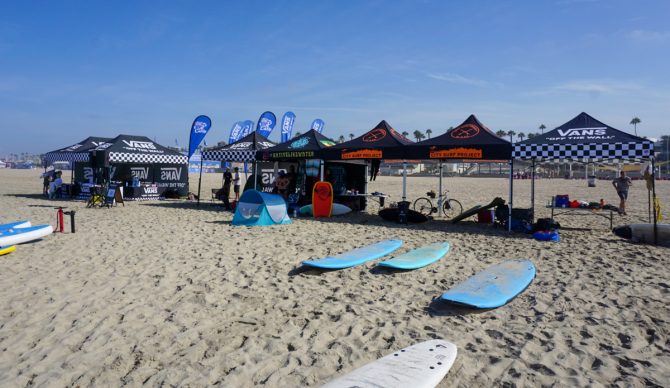
Take a lesson with a surf school, and you’ll likely find yourself on a foam surfboard. Photo: Will Sileo//The Inertia
Which brings us back to the question at hand. What’s the ideal size and shape for a beginner? Something between 7’6″ and 9′ will give you the volume you need to get up to speed when paddling quickly and give you the stability you need to get to your feet and remain on your feet. Size up or down according to your bodyweight and height – in general, the lighter and shorter you are, the less volume and surface area you will need for paddling and popping up because you’ll have a narrower stance and be lighter on your feet. If you’re taller or heavier, you’ll want to go longer for ease of paddling and to accommodate a broader stance.
Beyond differences in length and overall volume, you’ll notice most boards on our list are fairly similarly shaped – they feature round noses, have three fins, and are all in the 7′-9′ range. You might hear this shape called a “mini mal”, “funboard”, or “mid-length.” This is by design. Other considerations like the tail shape, rocker, and number of fins are surfboard design elements that begin to matter more as you start to think about hitting the lip for the first time. For now, the key focus is getting the most amount of waves possible.

Long, slow waves like this one are great for beginners – but you’ll want a longer, higher-volume board to help you paddle into the weaker waves. Photo: Will Sileo//The Inertia
A Word on Conditions in Choosing Your Beginner Surfboard
Where you’ll be learning to surf also matters when choosing the right beginner surfboard for your needs. At long, slow mushy waves, where it’s more so about paddling fast enough to get into the wave than it is about nailing the steep drop-in, you may want to go with a true longboard in the nine-foot-plus range. For waves with enough power where it’s more about being in the right position, the increased maneuverability of a funboard in the 8′ range will serve you better. As we’ve mentioned previously, kids, teens, and smaller adults can consider going less than 8′ for their first board, but it probably worth getting the advice of a surfer you know, or checking in at your local surf shop, before taking the plunge on a board that’s 7′ or less.
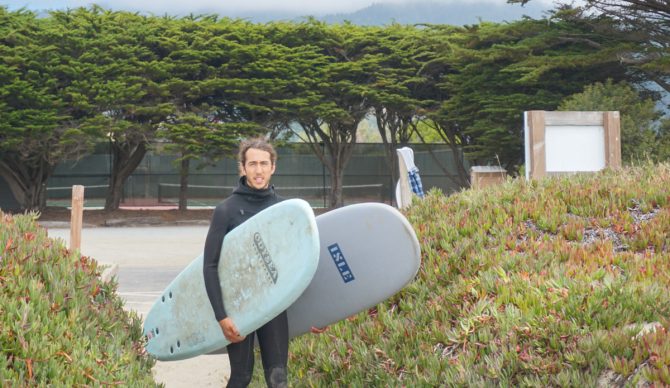
Both the Catch Surf Odysea Log and the ISLE Coronado are worthy options for your beginner surfboard. Photo: Quincy Sileo//The Inertia
How Much Should I Spend On a Beginner Surfboard?
For complete beginners who have no idea whether or not they’ll still be surfing in a couple of months and are looking to get their hands on a “true foam” surfboard, keep it cheap. It might even be worth borrowing a foamie from a friend (most surfers these days will have one or two lying around) or renting for a session or two. If you are ready to buy your own, though, we would, personally, try to stay below $400 for a true foamie surfboard.
If you’ve already spent some time borrowing a friend’s board (recommended) or are looking for a board that will last you through the true beginner stage into the beginner-intermediate stage of your surfing career, a more advanced “beginner surfboard” might be in order. That could be a “poly” fiberglass or epoxy-construction surfboard if you’re feeling ready for a hard board, or a soft-top epoxy surfboard like the ISLE Coronado if you’re looking for a bit less of a giant leap forward (but still a worthy upgrade in surfboard performance).
New fiberglass surfboards (especially longer boards) can reach up to $1000 – we certainly wouldn’t recommend spending that much on your first surfboard, but these boards can be found for much cheaper used. If you’d prefer not to try your luck on Craigslist, epoxy-construction, and soft-top epoxy boards typically hover around $500-700, but their upgraded performance over a true foam board and long-lasting durability can make that spend well worth it if you know your surfing obsession won’t be fading anytime soon.

“Trim is really about engaging with that speed of the wave and not doing anything. Making it look effortless and really, action without any action.” – Kassia Meador
Advice on Learning How To Surf
Not to discourage beginner surfers, but there is no easy path here. Becoming a good surfer requires lots of time in the ocean, which is one of the reasons it’s very challenging to learn as an adult. Grown humans are simply much more pressed for time than carefree children. You’re going to have to fall a lot. You’re going to need to learn to get comfortable in the ocean and understand all of the nuances of surf etiquette, of which there are many. Actually, standing up on a surfboard and riding a wave probably represents less than five percent of the time investment.
That said, many new surfers develop extremely fulfilling and lifelong relationships with riding waves, and we’d advise that you get a lesson from a local instructor, a friend, and/or supplement that experience with Kassia Meador’s Definitive Guide to Longboarding 2.0 from Inspire Courses. Kassia Meador is an icon of surfing, style, and grace. She’s also a charismatic and caring instructor, and her guidance will make the process of learning to surf much less intimidating. We wish you the best of luck on your surfing journey, and if we can be a helpful resource in any way, let us know in the comments or shoot us an email at info@theinertia.com. Cheers, and happy surfing.
Return to Comparison Table | Return to Top Picks
Editor’s Note: Don’t miss our guide to the Best Soft-Top Surfboards. And you’ll want to nab one of our Best Surfboard Leashes and probably one of the Best Wetsuits, unless you live in the tropics, in which case, take a look at the Best Boardshorts. For more surfboard options, we also have a guide to the Best Surfboards to Buy Online. For more surf gear reviews and features on The Inertia, click here.




